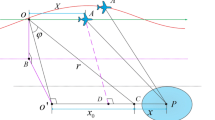Abstract
As residual attitude errors are likely to affect the synthetic aperture radar (SAR) imaging, this paper presents a SAR motion compensation algorithm based on the correction of residual attitude errors. The existing methods all use the antenna stable platform to correct the attitude errors, and then compensate the trajectory deviations in the following imaging process. Besides compensating the trajectory deviations, the modified method of this paper also considers the influence of residual attitude errors on the SAR imaging, and can compensate both the trajectory deviations and the residual attitude errors. Compared with the existing methods, the modified method in this paper can more precisely compensate the imperfect motion on the SAR imaging, especially good for the SAR system with a small platform, near operating distance and a narrow antenna beam. Such a system causes severe residual attitude errors and needs to consider the influence of antenna beam pointing errors on the imaging. The validity of the modified method presented by this paper is demonstrated by the result of the experiment.
Similar content being viewed by others
References
Cumming I G, Wong F H. Digital Processing of Synthetic Aperture Radar Data: Algorithms and Implementation. Norwood: Artech House, 2005. 21–112
Blacknell D, Freeman A, Quegan S, et al. Geometric Accuracy in Airborne SAR Images. IEEE Trans Aerosp Electron Syst, 1989, 25(2): 241–258
Guo Z Y, Deng Y K, Tu G F. Airborne SAR motion compensation based on IMU date and GEOSTAR integrated system. J Electron Inform Technol, 2007, 29(8): 1082–1084
Lv J Y. Study on Motion Compensation of Airborne Synthetic Aperture Radar. Doctor Dissertation. Beijing: Graduate University of the Chinese Academy of Sciences, 2006
Fornaro G, Franceschetti G, Perna S. Motion compensation errors: Effects on the accuracy of airborne SAR images. IEEE Trans Aerosp Electron Syst, 2005, 41(4): 1338–1352
Moreira A, Huang Y. Airborne SAR processing of highly squinted data using a chirp scaling approach with integrated motion compensation. IEEE Trans Geosci Remote Sens, 1994, 32(5): 1029–1040
Fornaro G. Trajectory deviations in airborne SAR: Analysis and compensation. IEEE Trans Aerosp Electron Syst, 1999, 35(3): 997–1009
Potsis A, Reigber A, Mittermayer J, et al. Improving the Focusing Properties of SAR Processors for Wide-band and Wide-beam Low Frequency Imaging. In: IGARSS’01. Sydney: IEEE, 2001. 3047–3049
Li X W. Study on motion compensation of airborne SAR based on phased array scanning technology. Master Dissertation. Beijing: Graduate University of the Chinese Academy of Sciences, 2009
Bao Z, Xing M D, Wang T. Radar Imaging Technology. Beijing: Publishing House of Electronics Industry, 2005. 132–139
Macedo K, Scheiber R. Precise topography- and aperture-dependent motion compensation for airborne SAR. IEEE Lett Geosci Remote Sens, 2005, 2(2): 172–176
Zhang C B. Synthetic Aperture Radar Principle, Systems Analysis and Application. Beijing: Science Press, 1989. 113–184
Lanari R, Fornaro G. A short discussion on the exact compensation of the SAR range-dependent range cell migration effect. IEEE Trans Geosci Remote Sens, 1997, 35(6): 1446–1452
Potsis A, Reigber A, Mittermayer J, et al. Sub-aperture algorithm for motion compensation improvement in wide-beam SAR data processing. Electron Lett, 2001, 37(23): 1405–1407
Berizzi F, Corsini G. Autofocusing of inverse synthetic aperture radar images using contrast optimization. IEEE Trans Aerosp Electron Syst, 1996, 32(3): 1185–1191
Lacomme P, Handange J, Marchais J, et al. Air and Spaceborne Radar Systems: An Introduction. Norwich: William Andrew Publishing, 2001. 87–115
Author information
Authors and Affiliations
Corresponding author
Rights and permissions
About this article
Cite this article
Ni, C., Wang, Y., Xu, X. et al. SAR motion compensation based on the correction of residual attitude errors. Sci. China Phys. Mech. Astron. 54, 1899 (2011). https://doi.org/10.1007/s11433-011-4478-7
Received:
Accepted:
Published:
DOI: https://doi.org/10.1007/s11433-011-4478-7




